The area of what is now Glasgow had been settled since neolithic times, but the establishment of the settlement that became the city of Glasgow came about with the founding of the church of Saint Mungo (or, Kentigern, as he was also called) on the banks of the Molendinar burn, a tributary of the Clyde, in the 6th century CE, in the Cumbric speaking Kingdom of Strathclyde. Saint Mungo went on to become the city's patron saint.

St Mungo - Glasgow's Patron Saint
At this time, the Clyde, which has its origins in the Lowther Hills of Lanarkshire, far to the south of the city, was a very wide, shallow river well stocked with salmon, trout and other fish, and the silting at the confluence of the Molendinar and Clyde made this suitable for a ford, which was the lowest crossing point on the river.
Following the unification of Scotland in the 9th century and the establishment of Glasgow as Scotland's second largest bishopric the town continued to grow and became a burgh under King William I, being granted various trading monopolies and other rights. Most of this trade was carried out, of course, by boats on the River Clyde, although the first bridge was built in 1285 connecting the town to the south bank of the river.
Glasgow grew further, with most of its Clyde-based trade at the time being in agriculture, fishing and brewing, although this wasn't helped by river and town being on the western side of the country, as much of the trade was with mainland Europe and the Mediterranean.
The establishment of Glasgow University in 1451, further boosted the town's fortunes, as did its elevation to Royal Burgh status in 1611, granting the city further trading privileges.
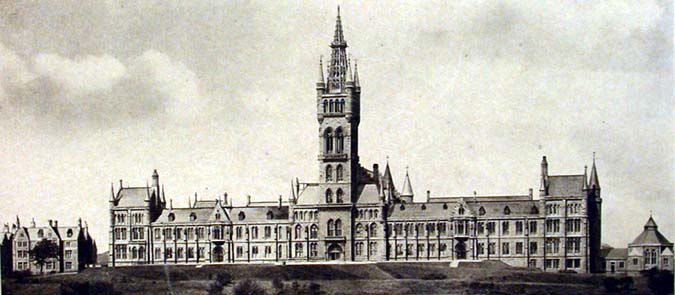
Glasgow University - Circa 1800s
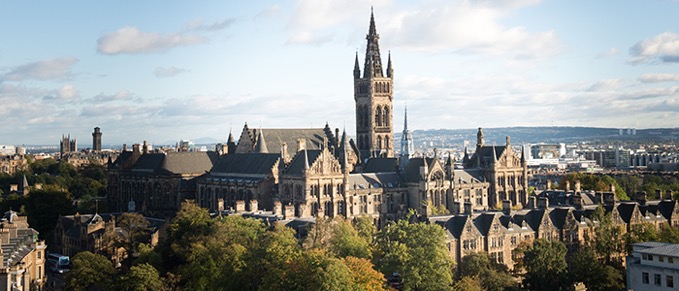
Glasgow University - Today
By now the city had grown to a population of around 7,000 but a period of unprecedented growth would shortly occur thanks to a combination of its location on the banks of a major river, political developments and the industrial revolution.
Being a burgh had made some traders wealthy men, and with the access granted to trade in the Americas, thanks to the Acts of Union in 1707, when the kingdoms of Scotland and England united to form the United Kingdom of Great Britain, their wealth greatly increased due to the trade in sugar, cotton and tobacco. Some of these men were so wealthy they earned the unofficial title of 'Tobacco Lords' and were responsible for the construction of several prominent buildings in the city as well as a deep water port further down the river Clyde, known as Port Glasgow, which allowed much larger vessels to ply the routes across the Atlantic. The tobacco lords were extremely rich men as trade burgeoned, with 21,000 tonnes of tobacco a year flowing through Glasgow, more than half of Great Britain's total tobacco imports.
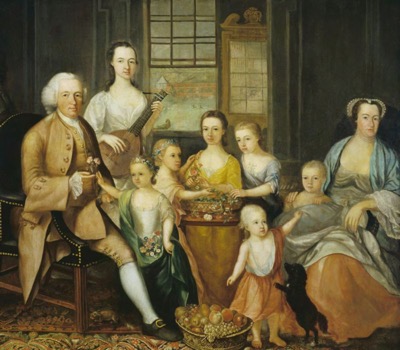
The Glassford Family - Circa 1767 - John Glassford - Glasgow Tobacco Lord
By 1795 the Monklands Canal had been opened giving easy access to the coal and iron ore mines of Lanarkshire and the decision was taken to narrow the river thus increasing the flow, which combined with dredging the silt, made it possible for much larger ships to reach the city and led to the birth of the industries for which Glasgow became world -famous, most notably, shipbuilding, but also engineering, printing, textiles, chemicals and much more. It also gave rise to the famous maxim, 'Glasgow made the Clyde, and the Clyde made Glasgow,' as the city prospered.
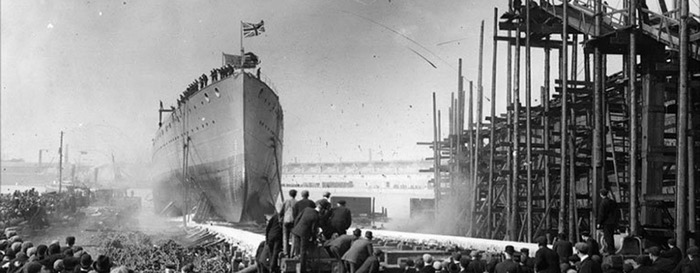
Govan Shipbuilders
During the 19th century the Clyde really came into its own as shipbuilding took off thanks to the deeper waters created by the narrowing and dredging. Several shipyards opened in Glasgow and the surrounding towns as the population grew steadily with incomers from all over Scotland, Ireland and England attracted by the employment opportunities.
Denny's of Dumbarton, a few miles further downriver from Glasgow, built the first steamship to cross the English Channel, the first turbine steamer and the first diesel-electric paddle steamer. The PS Comet became the first steamboat service in Europe, running from Glasgow to Greenock.
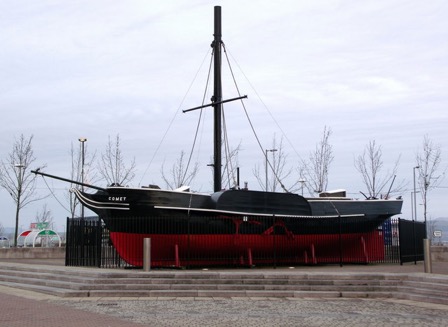
PS Comet replica can be found in Port Glasgow
Shipbuilding increased and more yards opened, notably John Brown's at Clydebank on the outskirts of the city, Fairfields at Govan, Yarrow's and others. In the late 19th and early 20th centuries the combination of access to raw materials, a large and skilled workforce and the deeper waters of the Clyde made Glasgow and the Clyde the world's foremost shipbuilding centre with one year in the early 20th century seeing one fifth of the all the ships in the world being launched on the river.
Other industries thrived too, with one quarter of all the rail locomotives in the world being produced in Glasgow at one point. Some of these, destined for export, were transported through the city streets and lifted onto waiting ships by the mighty Finnieston crane, which still stands on the north bank of the river as an industrial monument. The words 'Clyde built' became a byword for quality across the globe.
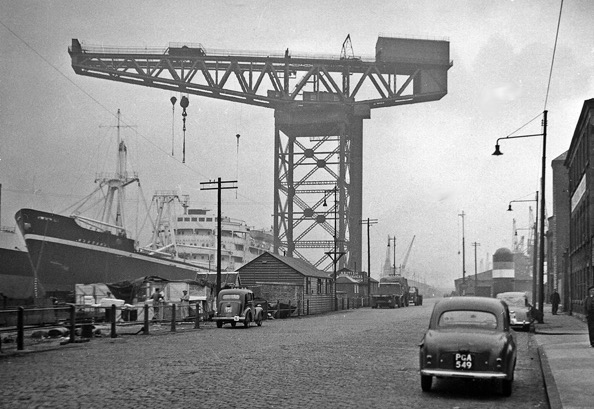
The Finnieston Crane - Then and Now
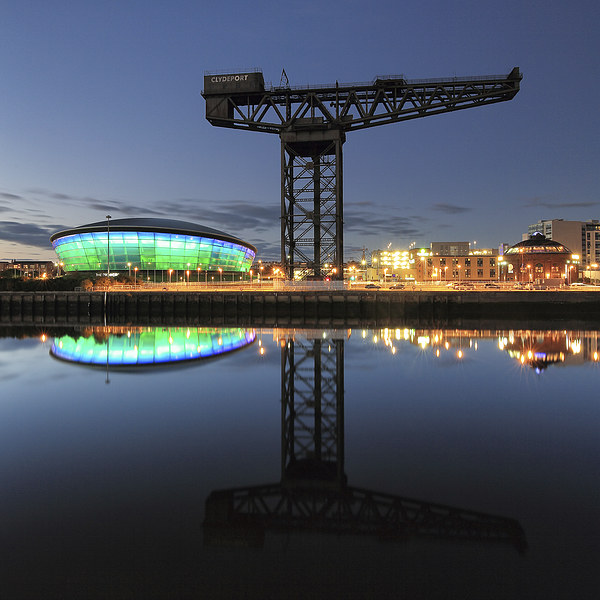
All this industrial activity and expansion led to a continued growth in the city's population with Glasgow being only the fourth city in Europe in modern times to surpass the one million mark in 1931, following in the footsteps of London, Paris and Berlin.
Shipbuilding went into a relative decline in the years between the World Wars, but Glasgow rose to the challenge again as ships were built for the UK's naval and merchant requirements in the Second World War. After this, however there was a marked decline with many yards unable to compete with the growing shipbuilding sectors in Asia, principally Japan, but later South Korea and China.
Shipyards closed and the Clyde became a shadow of its former self, with hardly a boat to be seen plying its waters, and warehouses and industrial premises lying abandoned along its banks. Many a Glaswegian has been reduced to tears when thinking about the river that gave us the likes of the Lusitania, the Queen Mary or the QE2 being reduced to this sad state of affairs.
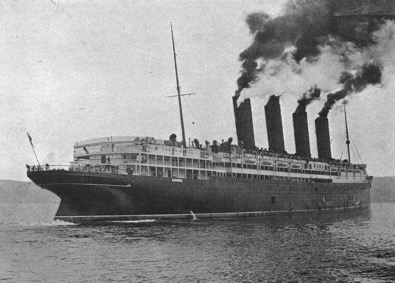
Lusitania
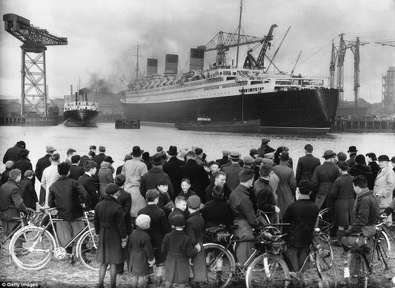
Queen Mary
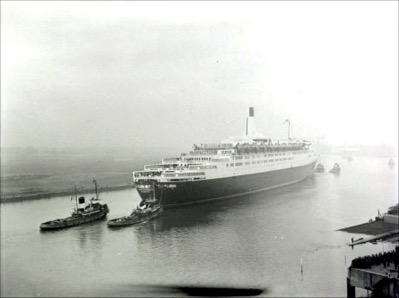
Queen Elizabeth II - Leaving Glasgow
Regeneration of the Clyde waterfront was talked about for many years and several projects were undertaken to revitalise what is still an iconic area for many of the city's residents. In 1985 the purpose-built Scottish Exhibition and Conference Centre opened its doors in Finnieston on the north bank, shortly followed by the hosting of the Glasgow Garden Festival in 1988 on former docklands in Govan on the south bank. These led to the city being awarded the title of European City of Culture in 1990.
It was left until the new century for a major co-ordinated regeneration project to get under way when the Clyde Waterfront project was initiated with hundreds of millions of pounds being pumped into a vast programme of building and reconstruction along the length of the river from Glasgow Green, Europe's first public park, in the heart of the city, to the town of Dumbarton some twenty kilometres downstream.
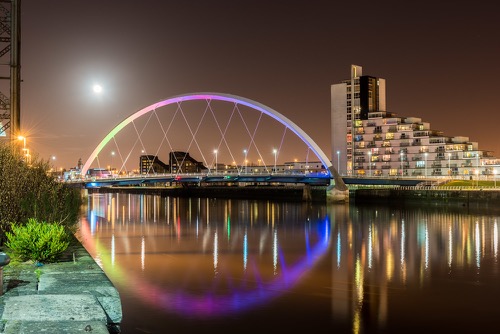
Clyde Arc Bridge Glasgow
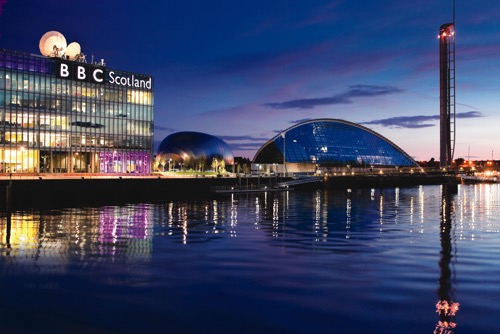
BBC Scotland Studios and the Science Centre on the Banks of the Clyde
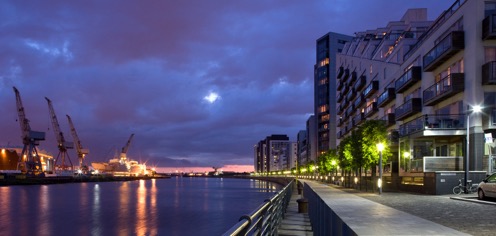
Clyde Waterfront Regeneration - Stylish apartment Blocks and Homes
This has led to billions of pounds of private and public funds being invested on the banks of the Clyde in an almost unrivalled urban renewal scheme that has led to new buildings, bridges, leisure facilities and industrial and community investment along the length of the river, transforming a once derelict, post-industrial wasteland into a thriving riverside area.
In many ways we have come full circle, with Glasgow once again making the Clyde and the Clyde re-making Glasgow.
We have number of properties which are ideally positioned for great views of the Clyde
See our
River Heights property,
The Heights - River and City View and our
Harbour Residence,
Tags: shipbuilding, st mungo, finnieston crane, Scottish Exhibition and Conference Centre, Clyde Waterfront, holiday home













